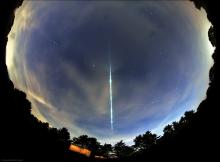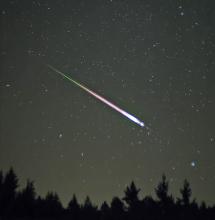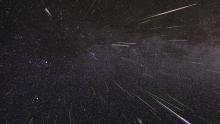Listen to today's episode of StarDate on the web the same day it airs in high-quality streaming audio without any extra ads or announcements. Choose a $8 one-month pass, or listen every day for a year for just $30.
You are here
Leonid Meteors
A meteor shower with a Jekyll-and-Hyde personality should be at its best over the next few nights. This is one of its “Jekyll” years, though, so it’ll be meek. At best, you might see 10 or so meteors per hour.
The Leonid meteors are spawned by Comet Tempel/Tuttle 55. It was discovered in 1866, and it returns to the inner solar system once every 33 years or so. As it orbits the Sun, it sheds comet dust — small bits of rock and dirt. Earth flies through trails of this material every November. The debris rams into our atmosphere, vaporizing as the glowing streaks of light known as meteors.
The shower shows its “Mr. Hyde” personality when the comet is closest to Earth, so the streams of particles are thickest. In 1866, for example, it produced up to a hundred thousand meteors per hour — the most spectacular meteor “storm” ever recorded.
Now, though, Tempel/Tuttle is far away, so the shower is puny. It’s expected to reach its peak tomorrow night. The best view comes in the hours before dawn, when your part of Earth turns most directly into the meteor stream. A second peak is possible on Monday night.
The shower is named for Leo, because the meteors appear to “rain” into the atmosphere from that direction. But they can bolt across any part of the sky, so you don’t have to look at Leo to see them. Find a dark, safe skywatching spot, bundle up against the chill, and watch the sky — for a meek showing of Leonid meteors.
Script by Damond Benningfield






